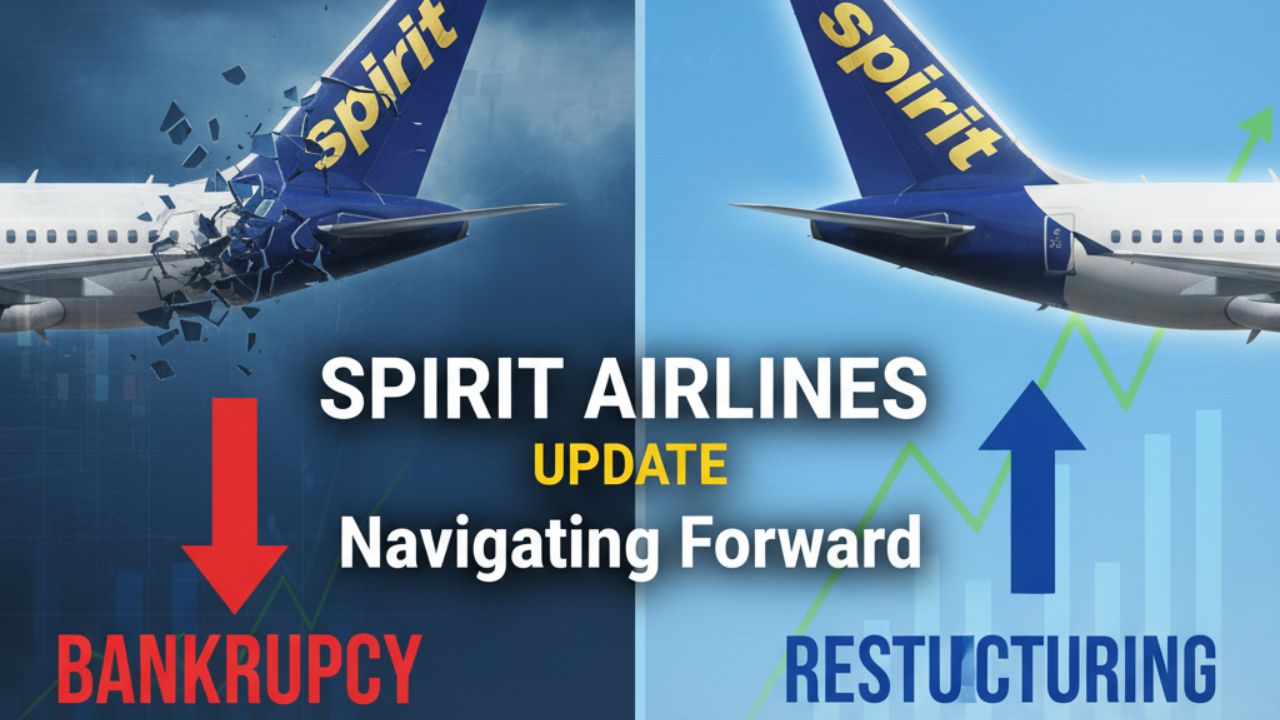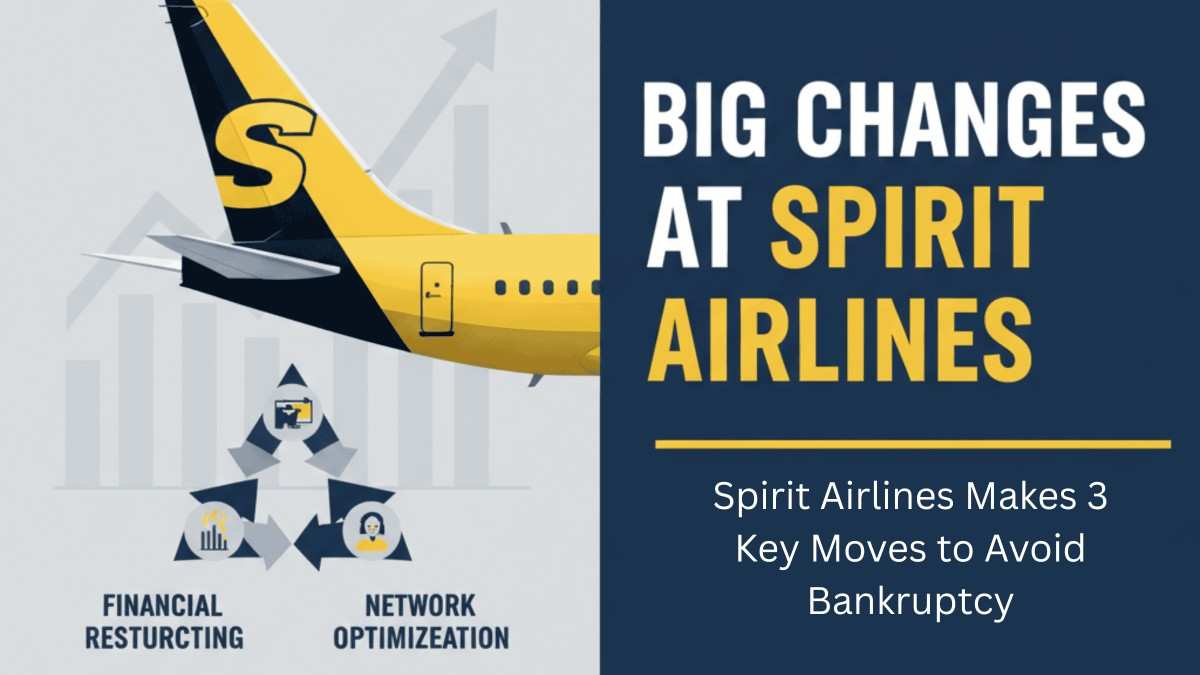
Spirit airlines has been one of the earliest and famous low-cost airlines of the United States, and throughout they have performed very well, but COVID-19 has totally broken their back. However, all the airlines have suffered equally at that time, but the recovery rate of Spirit was very low; still, they are suffering for profit, and this year they are failing to recover and even pay their normal debts. That’s why they have to file for bankruptcy twice in 2025. After Spirit Airlines' Bankruptcy, they announced plans to retire nearly 100 planes to survive, and they are also laying off 1800 staff members.
In this article, we’ll explore what bankruptcy means, why Spirit had to file twice in such a short time, the major steps the airline is taking to reorganise, and what travellers and employees can expect going forward.
What Is Bankruptcy and Why Did Spirit File Twice?
Bankruptcy in small is a legal process that helps businesses that are not in a condition to pay their debts. In bankruptcy, they usually tell the court that they are in a financially low condition and they need time to fix these things. It doesn’t mean the company disappears right away. It means that the company will make these drastic decisions in order to revive itself.
Analysing Spirit Airlines Bankruptcy news details, they have filed for Chapter 11 bankruptcy, in which the company continues to run while the economy deals with the debt. At this time, though, it will look to trim severely its cost structure, terminate disadvantageous contracts, and return to profitability.
Why Did Spirit Go Bankrupt the First Time?
Spirit has faced financial trouble for several years. The first filing of bankruptcy in March of the year 2025 came about because:
- During COVID-19, the company lost a fortune and never quite managed to regain it.
- An attempt to merge with JetBlue and Frontier was blocked and stopped.
- Spirit spent significant money trying to improve its image and add somewhat more premium services, which failed to attract sufficient new customers.
- The costs here were more than the income. A quarterly loss of as much as $246 million was recorded by it, and operating expenses hit $1.2 billion, 18% more than the revenue.
After coming out of its first bankruptcy, Spirit hoped the airline market would improve. There was, at one time, a general consensus out in the field that 2025 would stand as a growth year for the industry, but that did not unite.
What Happened After Spirit’s First Bankruptcy (March 2025)?
- The court said Spirit could use Chapter 11 bankruptcy, which means they could keep flying and running the airline while fixing their financial problems.
- Spirit Airlines completes $795 million debt restructuring by turning the debt it owed into shares of the company. This means some people who lent money agreed to own part of Spirit instead of getting paid back right away.
- The court made sure Spirit’s flights wouldn’t stop during this time, so passengers and workers weren’t hurt.
- The court watched closely to make sure Spirit followed its plan to save money and try to become successful again.
- After about four months, Spirit finished this part of the bankruptcy and came out with less debt and plans to improve.
Why Did Spirit File for Bankruptcy Again?
Just a few months after recovering, Spirit filed for bankruptcy again in August. This second filing happened because:
- There are many low-cost airlines in the market, and their tough competition is a reason for the very low fares.
- There are not many people flying, especially on Spirit's routes.
- And now the bigger airlines-the likes of Delta, United, and American-are also probing for cheap fares, making it tough for Spirit to cut a competitive edge.
- Spirit’s earlier changes didn’t save enough money fast enough.
As Fred Cromer said, “While the industry was hopeful at the beginning of 2025 that there would be a rebound, it didn’t happen.”
What Happened After Spirit’s Second Bankruptcy (August 2025)?
- The court accepted Spirit’s second bankruptcy because the airline was still experiencing financial problems and needed more time to fix things.
- Spirit got permission to borrow more money from bondholders to keep flying and paying bills during the fix.
- The court let Spirit use some money they had saved from before to pay for important things like employee salaries and fuel.
- Spirit was allowed to stop paying leases on many planes and close some airports and services that cost too much.
- The court approved a deal with AerCap, a big company that owns many of Spirit’s planes, where Spirit gave up some planes but got $150 million to help with its money problems.
- Spirit’s flights were allowed to keep running so travellers wouldn’t be affected.
- The court kept checking on Spirit’s progress and made sure they were updated about big changes, like worker talks and saving costs.
A rather large court meeting was set to take place on October 10, 2025, to decide on more money and the final plans for Spirit.
What Caused Spirit’s Financial Woes?
Spirit faced a number of problems along the pathway to its downfall:
- High Operating Costs: Fuel prices and labour costs kept costs high.
- Demand for Leisure Travel Was Not Strong: Less demand for Spirit from travellers resulted in lower ticket sales.
- Too Much Capacity: Too many LCCs implied competition became stiffer and profits thinner.
- Engine Malfunctions: Pratt & Whitney GTF engine recall grounds planes and adds expensive repairs.
- Failed Mergers: The failed merger agreement between JetBlue and Frontier gave rise to a situation in which managing the airline became more complex, and the innovation was put off.
Despite all the efforts to improve, the airline was already in deep financial trouble by the beginning of 2024.
How Is Spirit Using Bankruptcy to Save the Company?
To stay in business, Spirit is using this time to make major cuts and reorganise its operations. Spirit Airlines is following a restructuring support agreement as a part of its Chapter 11 bankruptcy filing. Here’s what they are doing:
Cutting the Fleet
- Spirit wants to retire around 100 aircraft.
- It filed a request in court to end 87 plane lease agreements.
- The aircraft are leased; hence, Spirit no longer wants to pay for them.
- The court must approve this request, but Spirit is in talks with the aircraft owners and lessors to see what can be worked out.
- The company has until October 27 to make its final determination on how many planes it wants to retain.
If approved, this cut will save Spirit hundreds of millions of dollars.
Cutting Airports and Routes
Spirit is also closing down many unprofitable routes and leaving several airports. These include:
- Exiting more than a dozen U.S. airports, such as Hartford, Connecticut, and Minneapolis, Minnesota.
- Ending about 40 routes that don’t make money.
- The court has approved Spirit’s request to reject 12 airport leases and 19 ground handling agreements. Ground handling includes things like baggage, fuel, and aeroplane cleaning.
cutting employees
- Spirit Airlines will lay off about 1,800 flight attendants to cut costs during its bankruptcy. Some layoffs will be voluntary, but others will begin in December if necessary.
- The airline has also reduced the number of pilots and is working with the pilots’ union to manage job cuts as part of its efforts to stay in business.
The $150 Million AerCap Deal
AerCap, Spirit’s largest aircraft lessor, plays a big role in the airline’s future:
- AerCap terminated leases on 36 future Airbus A320neo aircraft and declared defaults on 37 currently in service, hitting about a quarter of Spirit’s fleet.
Spirit signed a $150 million agreement with AerCap, whereby it would release 27 aircraft lease obligations for the sake of receiving interim funds to help in the restructuring.
The importance of this settlement is that it will put Spirit in a position to continue with fewer aircraft and, consequently, lower costs.
What Will Bankruptcy Imply for Spirit Employees and Travellers?
For Travelers
Spirit states that the flight schedules, booking, and reservations will continue as usual. The airline further reassures passengers of no disruptions even during the peak holiday period towards Labour Day.
For Employee
Spirit Airlines is going to furlough roughly 1,800 flight attendants as part of restructuring, which is about one-third of its entire cabin crew, in order to reduce expenses due to its second bankruptcy of the year. The voluntary furloughs have already been taken, and, therefore, the involuntary furloughs will commence on Dec. 1, with the attendants being allowed to maintain their medical benefits during the furlough. The union is trying to help the impacted members be placed with other airlines.
Selling the Older Planes to Get Cash
In addition to gradual retirement, Spirit is also offloading 23 out-of-date Airbus aircraft for the price of $519 million. The results of this process should be $225 million in cash by the next financial year, which will enable the Airline to pay the bills as well as to go on flying.
What’s Next for Spirit Airlines?
- There is a critical court hearing scheduled on October 10, 2025, concerning the approval of new financing and lease agreements.
- Spirit hopes to renegotiate terms with AerCap and other lessors to keep some next-generation Airbus planes.
- The company is proceeding with talks with labour unions geared toward cost reduction.
- Future decisions will shape how many routes and employees the airline retains.
The Big Picture: Will Spirit Survive?
After filing for bankruptcy twice in one year, Spirit Airlines is taking serious steps toward debt restructuring:
- Retiring nearly half of its fleet.
- Cutting down on airports and flight routes.
- Ending costly contracts and deals.
- Getting money through plane sales and settlements.
They believe that by reducing their operation scale, they will become more focused, efficient and financially stronger. But not wrong to say it is a very risky path to choose, and only time will tell its worth.
Spirit CEO Dave Davis said, “There is much more work to be done, but these significant steps help build a stronger Spirit and secure a future with high-value travel options for American consumers.”
CFO Fred Cromer added, “This is about building a much smaller and stronger Spirit Airlines.”
Conclusion
Spirit airlines is making some big decisions in the approach to surviving the financial crisis. Retiring almost 100 aircraft is the biggest move yet, showing how serious the company is about saving money and reshaping its future.
While this plan will likely yield a smaller Spirit, the hope of the airline will be for growth in strength and stability in the long run.
For now, travellers can keep flying, but Spirit’s future depends on whether these big changes can fix years of financial trouble. As CFO Fred Cromer said, this is about building “a much smaller and stronger Spirit Airlines.”





